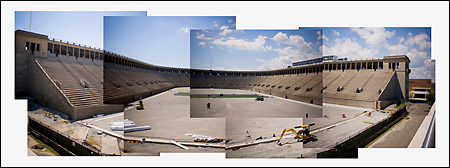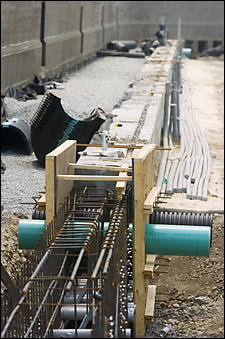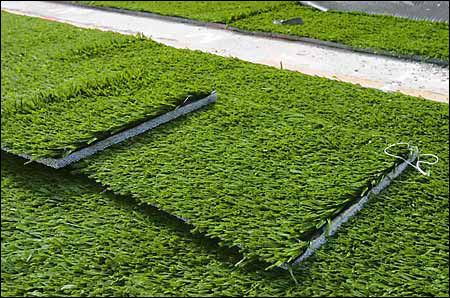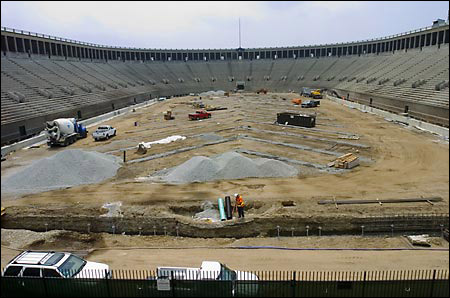Not just cosmetic: Stadium renovations include artificial turf, practice bubble
Programs delegating responsibility for diversity found more effective

Just as Harvard’s many classrooms, labs, and offices got settled into the relatively peaceful pace that tends to mark each summer season here on campus, an army of engineers, contractors, and workers busily moved the earth at Harvard Stadium. And made a mountain.
Keep up with
Crimson weekend action
Now, following four months of labor — largely spent digging, hauling, and piling some 125,000 square feet of dirt — workers from Boston-based Payton Construction have completed the first phase of a donor-funded $5 million improvement project to the storied landmark: replacing the field of the 103-year-old stadium with a 21st century synthetic surface known as FieldTurf.
The new turf, made of 3-inch-long grasslike fibers woven into cushiony mats, is notable for its blend of crushed recycled rubber (including old sneaker soles) and sand — a formula designed to replicate the feel and give of natural grass. Additionally, the infill provides traction on a par with natural grass, while increasing the field’s life expectancy. Specifically designed “low abrasion fibers,” meanwhile, reduce those nasty turf burns often associated with synthetic fields.

Given these tactical features, along with the virtually guaranteed pristine playing conditions artificial offers (goodbye, potholes), it’s little wonder that FieldTurf has become an increasingly popular choice among professional and college football programs alike. Indeed, Harvard football (which opens its season on Saturday [Sept. 16] versus a visiting Holy Cross team) joins co-Ivy Leaguers Columbia, Cornell, Dartmouth, Penn, and Princeton in going synthetic. With its subsurface drainage system and conduit system for telecommunication lines, this clearly is not your father’s artificial turf.
In October, the second phase of the renovation project will kick off with the installation of permanent lighting. The high-powered system will fit snugly into the railing cove just above the colonnade section, thereby preserving the original look and integrity of the stadium (deemed an official National Historic Landmark). The lights will be broadcast-friendly for television and will allow the football team to hold practices past dark, while greatly extending evening use for other intercollegiate and intramural teams.
Come late November, the stadium will jump right into the 22nd century when it introduces its third and final upgrade — an inflatable domelike “bubble” for housing wintertime sporting events and practices. Anchored to a concrete foundation, the bubble can be inflated within four hours by a permanent furnace located at the bottom of the stadium’s U shape. Visitors to the bubble will enter through a revolving door to maintain steady air pressure, while a series of sensors connected to the facility will monitor and adjust the structure’s pressure for handling heavy winds and external temperature for melting collected snowfall. Inside, the temperature will be kept at a balmy 72 degrees throughout the winter months. Taken together with the freshly laid turf, the bubble will greatly extend the use of the stadium complex for those varsity programs that compete in the elements. Likewise, the range of club, intramural, and recreational opportunities will flourish within its comfy confines.

According to Jeremy Gibson, Harvard’s associate director of athletics, who is overseeing the upgrades, there hasn’t been any outcry from purists about all the changes. “The availability and accessibility of the dome seem to far outweigh the changes taking place,” he explains. “It’s a spirited melding of an old look with new technology.”
Meanwhile, champions of the environment should also be pleased with all the changes at the stadium. That impressive mound of earth temporarily sitting behind the stadium (dubbed Mt. Sullivan in honor of Harvard’s Director of Athletic Communications Chuck Sullivan) will be reused as topsoil for the University’s rugby pitch.

To read about the stadium’s 2003 centennial, go to http://www.news-harvard.go-vip.net/gazette/gazette/2003/10.23/00-stadium.html.




